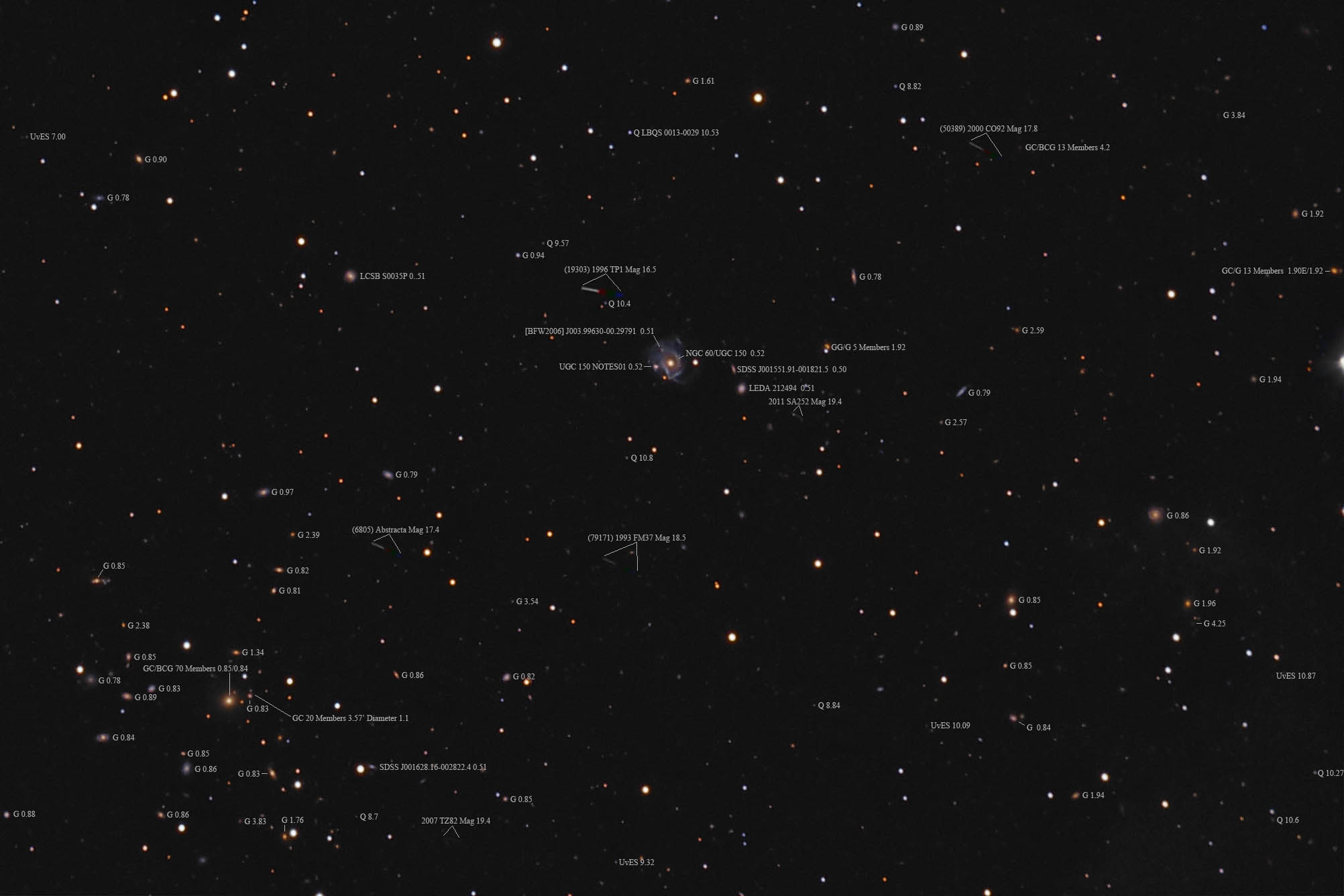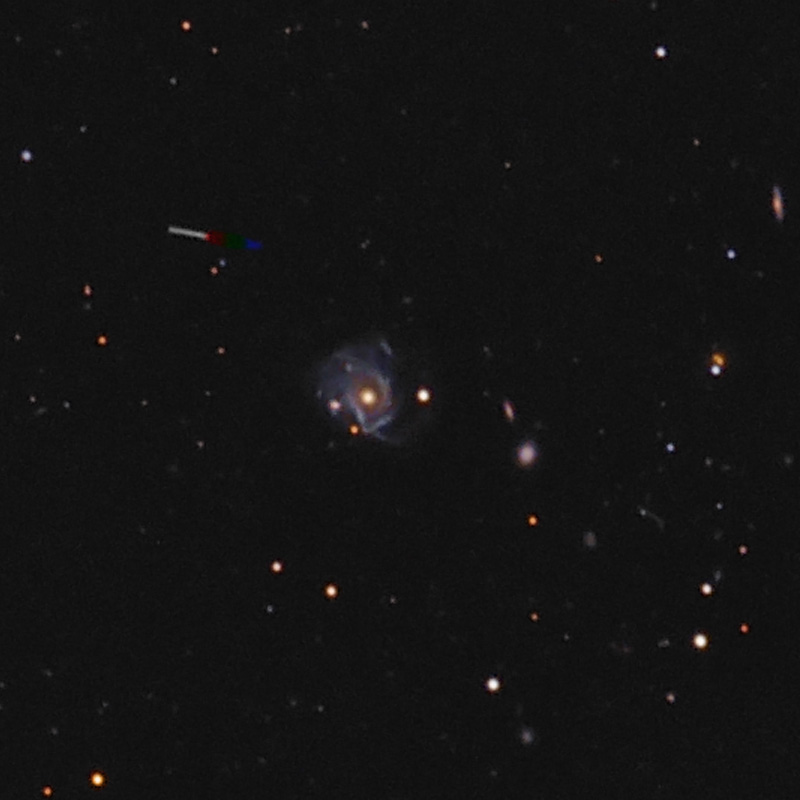Object name: NGC0060 NGC 60/UGC 150 is a rather chaotic spiral possibly interacting with a high surface brightness companion on its arm. Why Arp didn't include it in his category for such galaxies I don't know. Seems more deserving than some he did include though at the time he didn't realize they were often at very different distances. That's not the case here. These two have virtually the same redshift that puts them about a half billion light years distant. It is located in southern Pisces between Aquarius and Cetus. NED and the NGC project classify it as SA(r)cd pec. Peculiar it certainly is with its very weird arm structure. NED makes no attempt to classify its companion, however. It was discovered by Édouard Stephan on November 2, 1882.
There's a third object to consider. It is northeast of the core of NGC 60. While its listed redshift is listed as about the same as the other two this is a friends of friends estimate (based on the other two) so of course, it agrees! Is it a star cloud in the disk of NGC 60 or a third galaxy. NED considers it a separate galaxy. If correct are they right to use a FoF estimate for redshift? To me, it looks like a distant unrelated galaxy. However, looks can be deceiving.
There are several other galaxies in the field, two near NGC 60, the others scattered through the image, that appear to be part of the same group at about a half billion light-years. All are listed by catalog identification not just my usual G label for galaxies. Several other groups appear to exist in the image. one at just under 2 billion light-years, another at just under one billion light-years and another at a bit over 800 million light-years.
The image contains many quasars (Q) and quasar candidates (UvES). Arp seemed enamored with the idea they are nearby objects, with anomalous redshift, ejected from disturbed galaxies like NGC 60. Another reason I find it odd he overlooked this object. It's quite possible they were unknown at the time.
Quasar LBQS 0013-0029 at 10.53 billion light-years is north of NGC 60. It is quite interesting not for itself but for what is between it and us. NED lists 9 absorption line sources between the quasar and us. With their redshift distances they are:
[HB89] 0013-004 ABS01 at 10.44 billion light years
[HB89] 0013-004 ABS02 at 10.38 billion light years
[HB89] 0013-004 ABS03 at 10.36 billion light years
[HB89] 0013-004 ABS04 at 10.35 billion light years
[HB89] 0013-004 ABS05 at 10.34 billion light years
[HB89] 0013-004 ABS06 at 9.95 billion light years
[HB89] 0013-004 ABS07 at 9.87 billion light years
[HB89] 0013-004 ABS08 at 9.53 billion light years
[HB89] 0013-004 ABS09 at 4.65 billion light years
Each is a cloud of gas and likely dust that have added their absorption lines to those of the quasar. It must be fun untangling such a mess.
There are 6 asteroids in the image. I've listed them with their magnitude estimate from the Minor Planet Center. One has the name Abstracta. I had to look that one up. Here's the naming citation.
(6805) Abstracta = 4600 P-L
Named for the astronomical bibliography Astronomy and Astrophysics Abstracts. Founded in 1969, the AAA present a comprehensive documentation of all aspects of astronomy, astrophysics and related fields. The AAA are prepared under the auspices of the IAU by a special department of the Astronomisches Rechen-Institut, Heidelberg. The department, headed by Lutz D. Schmadel for the last 20 years, has recorded, abstracted and indexed more than 500,000 documents. AAA is the direct successor of the Astronomischer Jahresbericht, which was founded in 1900. The AAA already amount to more than 60 volumes, occupying more than 3 meters of shelf space.
Since I use this source a lot in my research I find the asteroid more interesting than normal.
14" LX200R @ f/10, L=4x10' RGB=2x10', STL-11000XM, Paramount ME Related Designation(s):2MASS J00155824-0018126, 2MASX J00155824-0018130, 6dF J0015582-001813, 6dFGSv 00132, APMUKS(BJ) B001324.76-003453.6, ASK 028709.0, CGCG 0013.4-0034, CGCG 382-037, KIG 0011:[VOV2007] 117, LQAC 003-000 040, MCG +00-01-048, Mr18:[BFW2006] 08854 NED02, Mr19:[BFW2006] 17868 NED02, NGC 0060, NGC0060, NSA 005769, PGC 001058, SDSS J001558.24-001812.6, SDSS J001558.24-001812.7, SDSS J001558.25-001812.6, UGC 00150, UZC J001558.2-001813, [BFW2006] J003.99268-00.30351 , [GVI2006] LSB 004, [ISI96] 0013-0034, | | 

